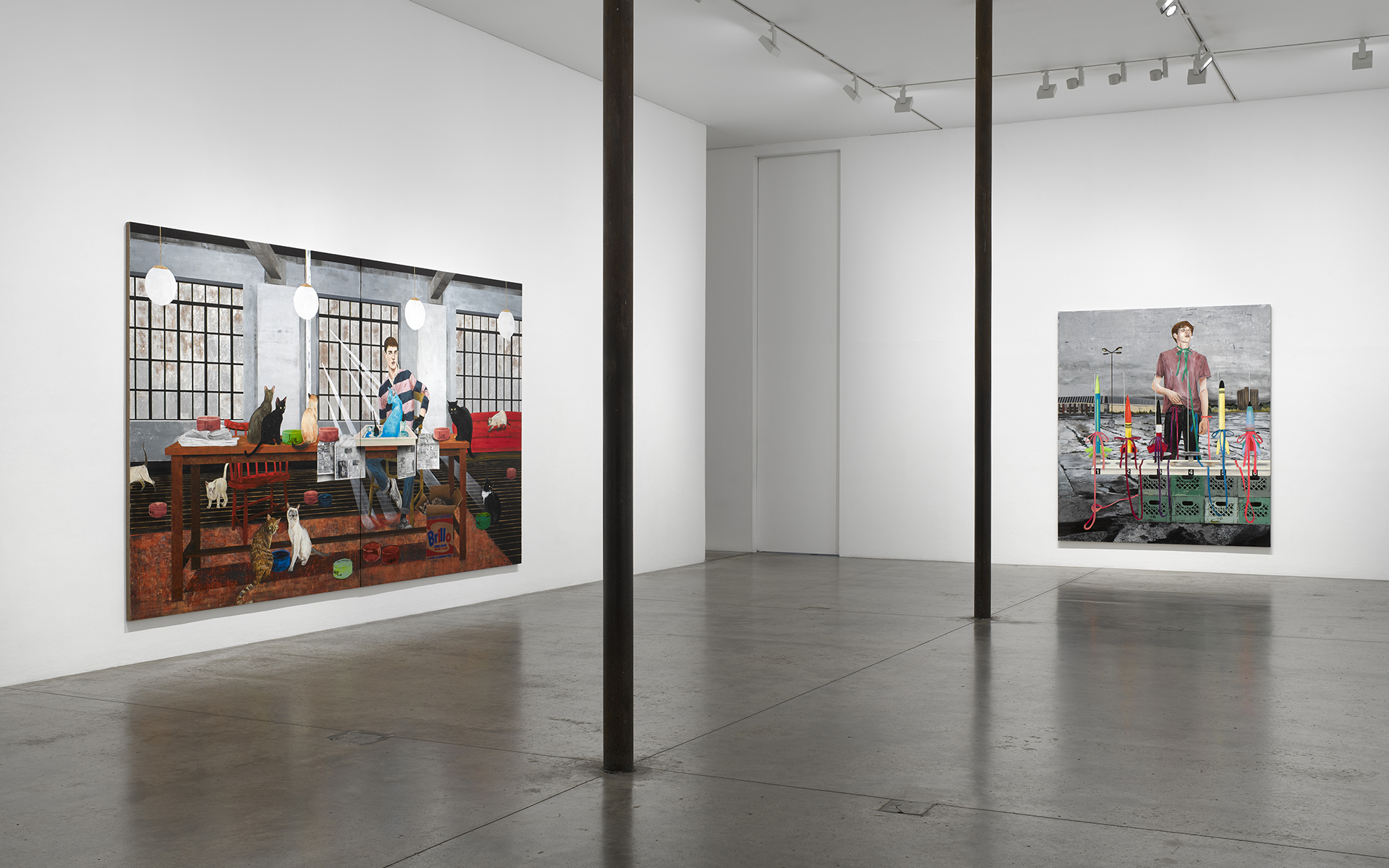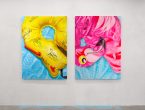Fordlândia Fieldwork
2012 - Installation (Installation)
Clarissa Tossin
In Fordlândia Fieldwork (2012), Tossin documents the remains of Henry Ford’s rubber enterprise Fordlândia, built in 1928 in the Brazilian Amazon to export cultivated rubber for the booming automobile industry. When his rubber trees died from disease and his primarily indigenous workforce revolted, his enterprise went busts within a few short years. Ford never faulted his own planning, but instead blamed the “inhospitable” Brazilian landscape. These topographical maps present different locations related to Fordlândia’s history: a current Fordlândia satellite image of the abandoned rubber plantation built by Ford in 1928, juxtaposed with postindustrial landscapes from Detroit, Dallas, and Los Angeles, is printed on the back side of the folded mapsculpture.
Clarissa Tossin’s photographs, videos, and installations are active investigations into the workings of urban planning and labor politics. The artist draws poignant parallels among historical events, creating engaging narratives that are also often subversive. Many of her works are concerned with what could be called a topography of place. Focusing on the promises, legacies, and failings of modernity, globalism, and utopian idealism, much of her work concentrates on cultural and economic connections between the United States and Latin American countries. Tossin’s most recent artwork, Archaeology of the Present, investigates the link between Indigenous civilizations and current Los Angeles via the lenses of gender and appropriation.
Colors:
Related works featuring themes of: » Contemporary Conceptualism, » Installation Art, » Brazil, » Globalization, » Color Photography, » Cross-Cultural Dialogue, » Brazilian
» see more

© » KADIST
Runo Lagomarsino
2020On Fire by Runo Lagomarsino comprises twenty pieces of parchment, each of which has had the contours and map of Brazil burned in stages...

© » KADIST
Runo Lagomarsino
2020Yo también soy humo (I am also smoke) is a 16mm film that has been digitized to video...
Other related works, blended automatically
» see more

© » KADIST
Clarissa Tossin
2017Clarissa Tossin’s film Ch’u Mayaa responds to Frank Lloyd Wright’s Hollyhock House (constructed 1919–21) in Los Angeles, an example of Mayan Revival architecture...

© » KADIST
Runo Lagomarsino
2020On Fire by Runo Lagomarsino comprises twenty pieces of parchment, each of which has had the contours and map of Brazil burned in stages...

© » KADIST
Runo Lagomarsino
2020Yo también soy humo (I am also smoke) is a 16mm film that has been digitized to video...

© » KADIST
Heman Chong
2012The work Calendars is composed of 1001 images of deserted public areas in Singapore printed on pages of a calendar set from the year of 2020 until 2096...
Related works sharing similar palette
» see more

© » GALERIE MAGAZINE
5 Museum Exhibitions to See in Miami During Art Basel - Galerie Subscribe Art + Culture Interiors Style + Design Emerging Artists Discoveries Artist Guide More Creative Minds Life Imitates Art Real estate Events Video Galerie House of Art and Design Subscribe About Press Advertising Contact Us Follow Galerie Sign up to receive our newsletter Subscribe Installation view of "Hernan Bas: The Conceptualists" at the Bass Museum of Art, Miami Beach...
Related works from the » 2010's created around » Los Angeles, California
» see more

© » KADIST
Will Rogan
2010MUM , the acronym used to title a series of Rogan’s small interventions on found magazines, stands for “Magic Unity Might,” the name of a vintage trade magic publication...

© » KADIST
Phillip Maisel
2015While his works can function as abstract, they are very much rooted in physicality and the possibilities that are inherent in the materials themselves...

© » KADIST
Matt Lipps
2011In the series Horizons (2010), Lipps uses appropriation to riff on Modernism’s fascination with abstract form...

© » KADIST
Ranu Mukherjee
2011Conceived as a large-scale mural-like projection, Color of History, Sweating Rocks is a neo-futuristic, hybrid film that combines cinematic language, collage, animation, and inventive forms to highlight the plight of the peoples of the Sahara—and refugees in general—who have been displaced by oil-mining....
Other works by: » Clarissa Tossin
» see more

© » KADIST
Clarissa Tossin
2017Clarissa Tossin’s film Ch’u Mayaa responds to Frank Lloyd Wright’s Hollyhock House (constructed 1919–21) in Los Angeles, an example of Mayan Revival architecture...
Related artist(s) to: Clarissa Tossin » Johanna Calle, » Matthew Buckingham, » Minerva Cuevas, » Adriana Bustos, » Adriana Lara, » Agnes Denes, » Allan Sekula, » Amalia Pica, » Andrea Bowers, » Andrea Geyer
» see more

© » KADIST
Matthew Buckingham
2002Matthew Buckingham presents a narrative directly connected with a highly symbolic site in the United States, the Mount Rushmore Memorial*...

© » KADIST
Allan Sekula
1973San Pedro is a seaside city, part of the Los Angeles Harbor, sitting on the edge of a channel...

© » KADIST
Minerva Cuevas
2006During her research on primitive currencies and cultural cannibalism, Cuevas came across the Donald Duck comic book issue “The Stone Money Mystery,” where Donald goes on a quest to find missing museum objects...

© » KADIST
Amalia Pica
2013Memorial for intersections #2 (2013) is a minimalist, black metallic structure that contains the brightly colored translucent circles, triangles, rectangles, and squares that originally were presented in Pica’s performance work A ? B ? C (2013)...
Related works found in the same semantic group
» see more

© » KADIST
Khvay Samnang
2014The video Rubber Man continues exploring issues related to land use, also noticeable in his Untitled series (2011)...

© » SOUTH CHINA MORNING POST
Giant Rubber Duck artist on why size matters – ‘instead of us looking at it, it is now looking at us’ – and his miniatures on show in Seoul | South China Morning Post Advertisement Advertisement Art + FOLLOW Get more with my NEWS A personalised news feed of stories that matter to you Learn more Dutch artist and “Rubber Duck” creator Florentijn Hofman in Hong Kong in June 23 for the return of his giant inflatable artwork to Victoria Harbour, this time with a twin...

© » KADIST
Adrían Balseca
2018The project Grabador Fantasma (Phantom Recorder) consists of a communally constructed technological device in Sarayaku ancestral territory...






